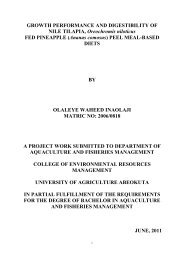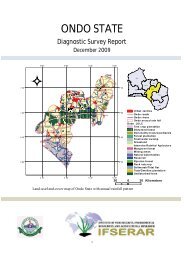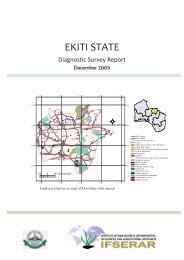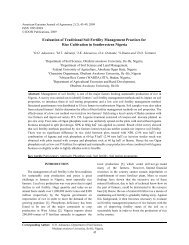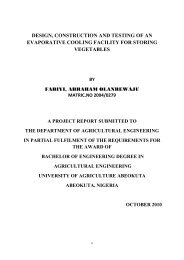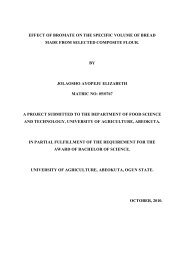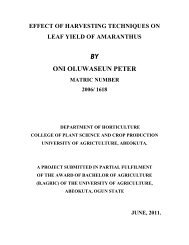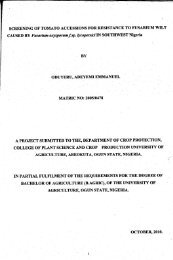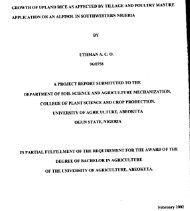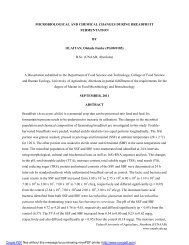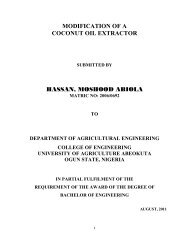presence of aflatoxins in smoked-dried fish sold in abeokuta, ogun ...
presence of aflatoxins in smoked-dried fish sold in abeokuta, ogun ...
presence of aflatoxins in smoked-dried fish sold in abeokuta, ogun ...
You also want an ePaper? Increase the reach of your titles
YUMPU automatically turns print PDFs into web optimized ePapers that Google loves.
1.1.1 Physical Characteristics<br />
Accord<strong>in</strong>g to ICRI (2000), Aspergillus flavus and Aspergillus parasiticus are mostly the molds<br />
that produce Aflatox<strong>in</strong> which are potent toxic, carc<strong>in</strong>ogenic, mutagenic, immunosuppressive<br />
agents. These fungi can produce their toxic compounds on almost any food that will support<br />
growth. Among 18 different types <strong>of</strong> <strong>aflatox<strong>in</strong>s</strong> identified, major members which are metabolites<br />
produced by these fungi are named AFB1, AFB2, AFG1, and AFG2, all which occur naturally.<br />
Of the four, AFB1 is found <strong>in</strong> highest concentrations followed by AFG1, AFB2 and AFG2.<br />
Aspergillus flavus only produces AFB1 and AFB2 and Aspergillus parasiticus produces these<br />
same metabolites along with G1 and G2. Aspergillus flavus typically produces AFB1 and AFB2<br />
whereas A. parasiticus produce AFG1 and AFG2 as well as AFB1 and AFB2. Four other<br />
<strong>aflatox<strong>in</strong>s</strong> M1, M2, B2A, G2A which may be produced <strong>in</strong> m<strong>in</strong>ute amount were subsequently<br />
isolated from cultures <strong>of</strong> A. flavus and A. parasiticus. A member <strong>of</strong> closely related compounds<br />
namely aflatox<strong>in</strong> GM1, parasiticol are also produced by A. flavus. Aflatox<strong>in</strong> M1 and M2 are<br />
major metabolites <strong>of</strong> aflatox<strong>in</strong> B1 and B2 respectively, found <strong>in</strong> milk <strong>of</strong> animals that have<br />
consumed feed contam<strong>in</strong>ated with <strong>aflatox<strong>in</strong>s</strong>.<br />
Description: Colourless to pale-yellow crystals. Intensely fluorescent <strong>in</strong> ultraviolet light,<br />
emitt<strong>in</strong>g blue (<strong>aflatox<strong>in</strong>s</strong> B1 and B2) or green (aflatox<strong>in</strong> G1) and green–blue (aflatox<strong>in</strong><br />
G2) fluorescence, from which the designations B and G were derived, or blue–violet<br />
fluorescence (aflatox<strong>in</strong> M1).<br />
Solubility: Very slightly soluble <strong>in</strong> water (10–30 µg/ml); <strong>in</strong>soluble <strong>in</strong> non-polar solvents;<br />
freely soluble <strong>in</strong> moderately polar organic solvents (e.g., chlor<strong>of</strong>orm and methanol) and<br />
especially <strong>in</strong> dimethyl sulfoxide (Cole & Cox, 1981).<br />
Melt<strong>in</strong>g-po<strong>in</strong>ts: see Table 1.<br />
Absorption spectroscopy: see Table 1<br />
1.1.2 Chemical Properties<br />
Stability: Unstable to ultraviolet light <strong>in</strong> the <strong>presence</strong> <strong>of</strong> oxygen, to extremes <strong>of</strong> pH (< 3,<br />
> 10) and to oxidiz<strong>in</strong>g agents.<br />
3



